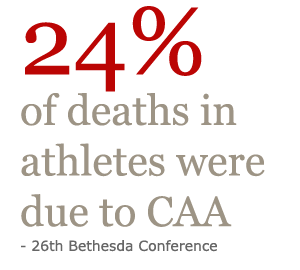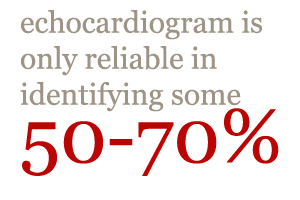For some 40 years, the medical literature has reported a
worrisome association between competitive sports activities and CAA and
related SCD.(1-7) The belief has become widely pervasive in the medical community, as well as the public at large, that any kind of CAA entails an increased risk of SCD, especially during sports activities. This belief was underscored by the landmark  guidelines published in 1994 by the 26th Bethesda Conference for
determining eligibility for competition in athletes with cardiovascular
abnormalities.(8) The authors alluded to
“coronary anomalies” as a generic label and stated that 24% of deaths in
athletes were due to CAA. Recent, more advanced studies have clarified
that about 5% of the general population carries some kind of CAA, but
only a few types of CAA (likely some 0.1-1%) by means of specific,
plausible and possibly quantifiable mechanisms have a high risk of
severity. (9-11) Unfortunately, in athletes,
some 80% of the cases of SCD considered to be due to CAA had that
outcome as their first clinical manifestation. Sports activities are intrinsically competitive, involving a need for maximal
physical performance. During training and especially during the
competition itself, athletes exceed their usual level of physical
activity going well beyond that reached during clinical stress testing. Sedentary persons have a lower probability of SCD (although their risk -
and that associated with less aggressive sports activities - has not
been evaluated in reasonable detail.) Until specific studies are
conducted according to strict criteria and protocols, the extent of
population screening that could be justified is still unclear.
guidelines published in 1994 by the 26th Bethesda Conference for
determining eligibility for competition in athletes with cardiovascular
abnormalities.(8) The authors alluded to
“coronary anomalies” as a generic label and stated that 24% of deaths in
athletes were due to CAA. Recent, more advanced studies have clarified
that about 5% of the general population carries some kind of CAA, but
only a few types of CAA (likely some 0.1-1%) by means of specific,
plausible and possibly quantifiable mechanisms have a high risk of
severity. (9-11) Unfortunately, in athletes,
some 80% of the cases of SCD considered to be due to CAA had that
outcome as their first clinical manifestation. Sports activities are intrinsically competitive, involving a need for maximal
physical performance. During training and especially during the
competition itself, athletes exceed their usual level of physical
activity going well beyond that reached during clinical stress testing. Sedentary persons have a lower probability of SCD (although their risk -
and that associated with less aggressive sports activities - has not
been evaluated in reasonable detail.) Until specific studies are
conducted according to strict criteria and protocols, the extent of
population screening that could be justified is still unclear.
The current procedure for screening athletes involves an annual medical
exam prior to the beginning of the athlete’s season. The exam consists
of listening to complaints that a candidate may volunteer, checking
blood pressure and measuring height and weight. The physician will also
listen with a stethoscope to theheart and lungs of the athlete. Only at
the university and professional level, do some physicians elect to use
instrumental testing, like an EKG and/or an echocardiogram to screen for
a heart condition. And, while an EKG is an inexpensive and expeditious
test, it often produces false negative or false positive  results that
can only confuse the public. Moreover, the echocardiogram is only
reliable in identifying some 50-70% of the important coronary anomalies,
which has resulted in the test not being considered an indicated
screening test. When CAT Scan Angiography is used, it involves the use
of a significant iodizing radiation dose and an intravenous injection of
iodine contrast. The MRI, with the characteristics employed in our
study, has a virtual 100% accuracy which will need to be confirmed and demonstrated in a large prospective series, as we are planning to
implement.
results that
can only confuse the public. Moreover, the echocardiogram is only
reliable in identifying some 50-70% of the important coronary anomalies,
which has resulted in the test not being considered an indicated
screening test. When CAT Scan Angiography is used, it involves the use
of a significant iodizing radiation dose and an intravenous injection of
iodine contrast. The MRI, with the characteristics employed in our
study, has a virtual 100% accuracy which will need to be confirmed and demonstrated in a large prospective series, as we are planning to
implement.
Likely, close
to 1% of the general population carries anomalous origin of a coronary
artery from the opposite sinus (hereinafter “ACAOS”). If young athletes
in the United States are 5 million per year, about 50,000 are expected
to have one of such anomalies.
In
particular, 0.1% of the general population is expected to carry
L-ACAOS, which implies that in any given year 5,000 young athletes are
at the highest risk. Some 0.9% of the general population is expected to a
carry the other significant, but less serious variant, R-ACAOS
accounting for 45,000 cases in the nation. 



